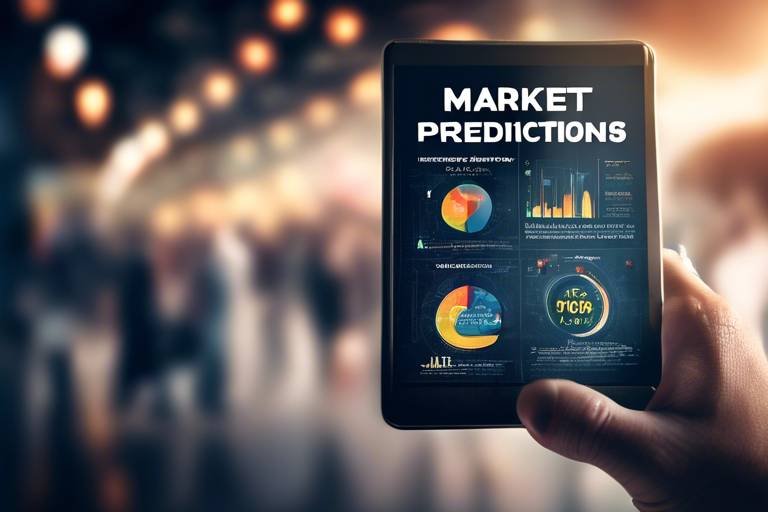Evaluating the Relationship Between Market Sentiment and Price
In the dynamic world of financial markets, understanding the intricate dance between market sentiment and price movements is crucial for investors and traders alike. Market sentiment encapsulates the collective feelings and attitudes of investors towards a specific asset or market, acting as a compass that guides their buying and selling decisions. This article aims to peel back the layers of this relationship, exploring how sentiment not only influences price dynamics but also shapes the broader landscape of trading strategies.
Imagine walking into a bustling marketplace, where the chatter of buyers and sellers creates an atmosphere charged with emotion. Just like in that marketplace, the financial world is rife with psychological undercurrents that can sway prices dramatically. When investors are feeling optimistic, prices tend to rise as demand increases. Conversely, when fear grips the market, prices can plummet as investors rush to sell. This emotional rollercoaster is what makes the study of market sentiment so fascinating and essential.
To truly grasp the relationship between sentiment and price, we must first delve into the factors that shape market sentiment. Investor psychology plays a pivotal role here, as emotions like fear and greed can lead to irrational decision-making. For instance, during a market rally, the overwhelming sense of optimism can lead to a bubble, while during a downturn, panic can cause a mass exodus from the market. Understanding these psychological triggers helps investors anticipate price movements and make more informed decisions.
Furthermore, tools like the Fear and Greed Index provide valuable insights into market sentiment. This index quantifies emotions in the market, offering a snapshot of whether investors are feeling fearful or greedy. When the index indicates extreme fear, it might signal a buying opportunity, whereas extreme greed could suggest that it’s time to sell. Such tools not only enhance our understanding of sentiment but also equip traders with the knowledge to navigate the turbulent waters of the market.
Another fascinating aspect of market sentiment is herd behavior. This phenomenon occurs when investors collectively follow the crowd, often leading to exaggerated price movements. Picture a flock of birds taking flight; when one bird moves, the rest follow without questioning. In financial markets, this behavior can create trends that may not necessarily align with fundamental values. Recognizing herd behavior is key for traders looking to capitalize on market inefficiencies.
As we explore the correlation between sentiment and price, it becomes evident that historical data can reveal intriguing patterns. By analyzing past market events, we can uncover how shifts in sentiment have historically influenced price dynamics. For example, during the 2008 financial crisis, fear dominated the market, leading to significant price declines. Conversely, the post-pandemic recovery saw a surge in optimism, driving prices to new heights.
Ultimately, understanding the interplay between market sentiment and price is not just an academic exercise; it has real-world implications for trading strategies. Investors who can accurately gauge sentiment can enhance their decision-making processes, leading to better risk management and potentially higher returns. By incorporating sentiment analysis into their trading toolkit, they can navigate the complexities of the market with greater confidence.
- What is market sentiment? Market sentiment refers to the overall attitude of investors towards a particular market or asset, influencing their buying and selling decisions.
- How does investor psychology affect market sentiment? Investor psychology, including emotions like fear and greed, can lead to irrational decision-making, significantly impacting market sentiment and price movements.
- What is the Fear and Greed Index? The Fear and Greed Index is a tool that measures market sentiment based on emotions, helping investors gauge potential market movements.
- What role does herd behavior play in the markets? Herd behavior occurs when investors follow the crowd, which can lead to exaggerated price movements and trends that may not reflect fundamental values.
- How can understanding sentiment improve trading strategies? By analyzing market sentiment, traders can make more informed decisions, enhancing their risk management and potentially increasing their returns.

Understanding Market Sentiment
Market sentiment is more than just a buzzword; it’s the heartbeat of financial markets. It reflects the overall attitude of investors toward a particular market or asset, shaping their buying and selling decisions. Just imagine walking into a crowded room where everyone is buzzing with excitement about a new product. That energy, that collective feeling, is akin to market sentiment. It can swing from extreme optimism to deep pessimism, often swaying prices in ways that might seem irrational at first glance.
At its core, market sentiment is driven by a myriad of psychological factors. Investors aren’t just numbers on a spreadsheet; they’re human beings influenced by emotions, experiences, and even the news they consume. When the market is soaring, it’s easy to feel like a genius for investing. Conversely, during downturns, fear can grip even the most seasoned investors, leading to hasty decisions. This emotional rollercoaster is fueled by cognitive biases—those little quirks in our thinking that can lead us astray. For instance, the confirmation bias makes us seek out information that supports our existing beliefs, while ignoring evidence that contradicts them.
Moreover, market sentiment can be infectious. When a few investors start to panic, it can trigger a domino effect, leading others to follow suit. This phenomenon is often referred to as herd behavior, where individuals mimic the actions of a larger group, rather than relying on their own analysis. It’s a classic case of “if everyone is doing it, it must be right,” which can lead to inflated prices during booms and steep declines during busts.
Understanding market sentiment is crucial for any investor. It’s like having a sixth sense that allows you to navigate the unpredictable waters of financial markets. By gauging the mood of the market, investors can make more informed decisions. For instance, if sentiment is overwhelmingly positive, it might be a good time to consider selling, while a negative sentiment could signal a buying opportunity. The key is to stay attuned to the emotional climate of the market and recognize that it can change in an instant.
In summary, market sentiment is a complex interplay of psychology, emotions, and collective behavior. As an investor, being aware of these dynamics can provide a significant advantage. After all, in the world of finance, it's not just about numbers; it's about understanding the story behind those numbers and the emotions that drive them.

Price Dynamics Explained
When we talk about price dynamics, we're diving into the fascinating world of how asset prices move and fluctuate over time. It's like watching a thrilling roller coaster ride—sometimes it goes up, sometimes it drops, and there are twists and turns that can leave you breathless. So, what exactly influences these price changes? Well, several fundamental principles govern how and why prices react to various factors, particularly market sentiment.
At the heart of price dynamics is the principle of supply and demand. Imagine you're at a popular concert. If the demand for tickets exceeds supply, prices skyrocket. Conversely, if there are too many tickets available and not enough buyers, prices plummet. This basic economic principle applies to financial markets as well. When investors are feeling optimistic, they’re more likely to buy, pushing prices up. On the flip side, when fear creeps in, selling ensues, and prices take a nosedive.
Another critical aspect of price dynamics is the role of market news and events. Think of this as the news ticker that runs across your television screen. Positive news can act like a shot of adrenaline for prices, while negative news can send them spiraling downwards. For instance, a company announcing better-than-expected earnings will likely see its stock price surge. In contrast, news about a scandal or poor performance can lead to a sharp decline. This relationship between news and price movement is what makes the financial markets so unpredictable yet exciting.
Additionally, technical analysis plays a significant role in understanding price dynamics. Traders often rely on charts and indicators to predict future price movements based on historical data. For example, they might look at patterns like head and shoulders or moving averages to gauge whether a price is likely to rise or fall. This analytical approach can sometimes create a self-fulfilling prophecy, where traders act on these signals, causing prices to move in the predicted direction.
Moreover, let’s not forget about the influence of institutional investors. These large entities, such as mutual funds and pension funds, can significantly impact price dynamics. When they decide to buy or sell large quantities of an asset, the ripple effect can be substantial. It’s akin to a giant wave crashing onto the shore—when it hits, it changes everything in its vicinity. Their actions can create trends that individual investors might follow, further amplifying price movements.
In summary, price dynamics are influenced by a complex interplay of supply and demand, market news, technical analysis, and the actions of institutional investors. Understanding these factors can empower investors to make more informed decisions and anticipate market movements. As we delve deeper into the relationship between market sentiment and price, it's crucial to recognize that while we can analyze trends and patterns, the markets will always retain an element of surprise—just like life itself!
- What is price dynamics? Price dynamics refer to the fluctuations and movements of asset prices over time, influenced by various factors such as supply and demand, market sentiment, and investor behavior.
- How does market sentiment affect price dynamics? Market sentiment shapes investor behavior, leading to buying or selling decisions that directly impact asset prices. Positive sentiment can drive prices up, while negative sentiment can cause declines.
- What role do institutional investors play in price dynamics? Institutional investors can significantly influence price movements due to their ability to buy or sell large quantities of assets, creating trends that other investors may follow.

The Role of Investor Psychology
Investor psychology is an intriguing and complex aspect of financial markets that significantly influences market sentiment. At its core, it encompasses the emotional and cognitive factors that drive investors' decisions, often leading them to act in ways that defy traditional economic theories. Imagine walking into a crowded room where everyone's buzzing about a hot new stock; the energy is palpable, and suddenly, you feel the urge to jump on the bandwagon. This phenomenon is a prime example of how emotions can sway rational judgment.
One of the most notable cognitive biases affecting investor psychology is confirmation bias. This occurs when investors seek out information that confirms their pre-existing beliefs while ignoring data that contradicts them. For instance, if an investor is bullish on a particular stock, they might only read positive news articles about it, disregarding any negative reports. This selective perception can create a distorted view of reality, leading to poor investment choices.
Moreover, emotional factors such as fear and greed play a pivotal role in shaping market sentiment. When the market is booming, greed can drive investors to take excessive risks, often resulting in inflated prices. Conversely, during downturns, fear can cause panic selling, which exacerbates price declines. This cyclical nature of emotions can create a volatile market environment where prices fluctuate wildly based on collective sentiment rather than underlying fundamentals.
Another interesting aspect of investor psychology is the concept of loss aversion. This principle suggests that the pain of losing money is psychologically more impactful than the pleasure of gaining money. As a result, investors may hold onto losing investments for too long, hoping to break even, while quickly selling off winners to lock in gains. This behavior can distort market dynamics, as it often leads to prolonged periods of price stagnation or decline.
To illustrate these psychological factors, consider the following table that summarizes key biases and their impact on investor behavior:
| Cognitive Bias | Description | Impact on Market Sentiment |
|---|---|---|
| Confirmation Bias | Seeking information that confirms existing beliefs | Can lead to overconfidence and market bubbles |
| Loss Aversion | Preference to avoid losses over acquiring gains | Results in holding onto losing investments |
| Herd Behavior | Following the crowd in investment decisions | Can create market trends based on collective actions |
Understanding these psychological factors is crucial for investors aiming to navigate the unpredictable waters of the financial markets. By acknowledging the impact of emotions and cognitive biases, investors can develop strategies to mitigate their effects. For instance, implementing a disciplined investment plan that includes predetermined entry and exit points can help counteract the impulsive decisions driven by fear and greed.
In conclusion, investor psychology is a powerful force that shapes market sentiment and price movements. By recognizing the various emotional and cognitive factors at play, investors can make more informed decisions and potentially enhance their trading strategies. After all, in the world of investing, understanding how we think and feel about money can be just as important as understanding the numbers.
- What is investor psychology? Investor psychology refers to the emotional and cognitive factors that influence investors' decisions in the financial markets.
- How does fear and greed impact market sentiment? Fear can lead to panic selling, while greed can drive excessive risk-taking, both of which significantly affect market prices.
- What are some common cognitive biases among investors? Common biases include confirmation bias, loss aversion, and herd behavior, all of which can distort rational decision-making.

Fear and Greed Index
The serves as a fascinating barometer for gauging market sentiment, encapsulating the emotional landscape that influences investor behavior. This index, developed by CNNMoney, quantifies the prevailing emotions in the market, categorizing them into two primary sentiments: fear and greed. Why is this important? Well, understanding whether the market is driven by fear or greed can provide invaluable insights into potential price movements. When investors are gripped by fear, they may sell off assets, leading to a decrease in prices. Conversely, when greed takes hold, investors are likely to buy aggressively, driving prices up.
The index is calculated using a range of factors, including market volatility, stock price momentum, and social media sentiment. Each component contributes to a score that ranges from 0 to 100, where 0 indicates extreme fear and 100 signifies extreme greed. This score is not just a number; it’s a reflection of collective investor psychology. For instance, a score below 20 suggests that fear is prevalent, often indicating a potential buying opportunity as prices may be undervalued. On the flip side, a score above 80 signals extreme greed, which might be a warning sign for investors to consider taking profits.
To give you a clearer picture, here’s a simplified breakdown of how the Fear and Greed Index is structured:
| Score Range | Sentiment | Investor Action |
|---|---|---|
| 0-20 | Extreme Fear | Potential buying opportunity |
| 21-40 | Fear | Caution advised |
| 41-60 | Neutral | Market stability |
| 61-80 | Greed | Consider profit-taking |
| 81-100 | Extreme Greed | Market may be overvalued |
In essence, the Fear and Greed Index serves as a compass for investors navigating the tumultuous seas of the financial markets. By keeping an eye on this index, traders can better understand when to enter or exit positions based on prevailing market sentiments. It’s like having a sixth sense that alerts you to the emotional undercurrents that could impact your investments.
However, it’s crucial to remember that while the Fear and Greed Index is a powerful tool, it should not be used in isolation. It’s best utilized in conjunction with other analytical methods to form a comprehensive view of market conditions. After all, in the world of investing, emotions can be just as influential as the numbers themselves.

Herd Behavior in Markets
Herd behavior is a fascinating phenomenon that occurs when investors collectively follow the actions of others, often leading to irrational market movements. Imagine a flock of birds taking off in unison; one bird's decision to fly can trigger a cascade of similar actions. In financial markets, this can manifest as a rush to buy or sell assets based on the prevailing sentiment rather than fundamental analysis. This behavior can significantly impact market dynamics, as it often amplifies price movements—both upward and downward.
When investors succumb to herd mentality, they may overlook critical data and analysis, instead choosing to align with the crowd. This can lead to bubbles, where asset prices soar to unsustainable levels, or crashes, where panic selling drives prices down sharply. The psychological underpinnings of herd behavior are deeply rooted in our social nature; we tend to feel more secure when we see others acting in a particular way. This instinct can be traced back to evolutionary survival mechanisms, where following the group could mean safety from predators.
To illustrate the impact of herd behavior, consider the following examples:
- The Dot-Com Bubble: In the late 1990s, investors flocked to technology stocks, driven by the belief that the internet would transform the economy. This herd mentality led to inflated prices that ultimately crashed in 2000.
- The 2008 Financial Crisis: During this period, many investors sold off mortgage-backed securities en masse, fearing widespread defaults. This panic selling exacerbated the financial downturn.
The implications of herd behavior are profound. It can lead to significant market inefficiencies and create opportunities for savvy investors who can recognize when the crowd is wrong. By understanding the triggers of herd behavior—such as news events, social media trends, or market rumors—investors can position themselves to take advantage of market mispricings.
In conclusion, while herd behavior can create short-term market movements, a deeper understanding of its implications can empower investors to make more informed decisions. By resisting the urge to follow the crowd and instead relying on sound analysis, one can navigate the complexities of market sentiment more effectively.

Measuring Market Sentiment
Understanding how to measure market sentiment is crucial for investors looking to navigate the often tumultuous waters of financial markets. Market sentiment is not just a vague concept; it can be quantified using various tools and indicators that provide insights into the collective mood of investors. These measurements can help traders anticipate market movements and make informed decisions. So, how do we actually measure something as abstract as sentiment? Let’s dive into some of the most popular methods!
One of the most straightforward ways to gauge market sentiment is through surveys. Organizations often conduct surveys that ask investors about their outlook on the market or specific assets. The results can be compiled into sentiment indices, which reflect the overall mood of the market. For instance, if a significant number of investors express optimism, it may indicate a bullish sentiment, while widespread pessimism can signal bearish trends.
Another increasingly popular method is social media analysis. In today’s digital age, platforms like Twitter and Reddit have become hotspots for investor discussions. By analyzing the volume and sentiment of posts related to certain stocks or markets, analysts can gauge how the general public feels about those assets. For example, a surge in positive tweets about a particular stock could suggest a growing interest, potentially driving prices up.
Technical indicators also play a vital role in measuring market sentiment. One such tool is the Put/Call Ratio, which compares the volume of put options to call options. A high ratio typically indicates bearish sentiment, while a low ratio suggests bullish sentiment. Additionally, the Volatility Index (VIX), often referred to as the "fear index," measures market expectations of near-term volatility. A rising VIX indicates increased fear among investors, which can lead to price declines.
To summarize, measuring market sentiment involves a combination of qualitative and quantitative methods, including:
- Surveys and sentiment indices
- Social media analysis
- Technical indicators like the Put/Call Ratio and VIX
Each of these methods offers unique insights and can be used in conjunction to provide a more comprehensive view of market sentiment. By effectively measuring sentiment, traders can position themselves to capitalize on potential market movements and mitigate risks. Remember, in the world of investing, knowledge is power, and understanding sentiment is a key component of that knowledge!
Q: What is market sentiment?
A: Market sentiment refers to the overall attitude of investors toward a particular market or asset, which influences their buying and selling decisions.
Q: How can I measure market sentiment?
A: Market sentiment can be measured through surveys, social media analysis, and technical indicators like the Put/Call Ratio and VIX.
Q: Why is understanding market sentiment important?
A: Understanding market sentiment helps investors anticipate potential price movements, allowing for more informed trading decisions and better risk management.

Correlation Between Sentiment and Price
The relationship between market sentiment and price movements is a fascinating area of study for investors and analysts alike. Understanding how these two elements interact can be the key to unlocking profitable trading strategies. Essentially, market sentiment acts as a barometer for investor emotions, which can significantly influence price dynamics. When sentiment is positive, prices tend to rise as investors are more willing to buy. Conversely, negative sentiment can lead to price declines as fear grips the market. This correlation is not just a theoretical concept; it is backed by historical data and real-world examples.
To illustrate this correlation, let's consider some historical trends. For instance, during the tech bubble of the late 1990s, exuberant market sentiment led to skyrocketing prices for tech stocks. Investors, caught up in the hype, often ignored fundamental valuations, driving prices to unsustainable levels. When sentiment shifted in the early 2000s, reality set in, and the subsequent crash was a stark reminder of how quickly prices can fall when investor confidence wanes.
Moreover, the correlation between sentiment and price can often be quantified through various analytical methods. One popular approach is to utilize sentiment indicators, which gauge the mood of the market. These indicators can take many forms, including:
- Surveys: Polling investors about their outlook can provide insights into market sentiment.
- Social Media Analysis: Monitoring platforms like Twitter and Reddit can reveal real-time sentiment shifts.
- Technical Indicators: Tools such as the Relative Strength Index (RSI) can help assess whether an asset is overbought or oversold, often reflecting underlying sentiment.
Examining the correlation quantitatively can be done through statistical methods, such as correlation coefficients. A positive correlation coefficient close to +1 indicates a strong relationship where rising sentiment corresponds to rising prices. Conversely, a coefficient near -1 suggests that as sentiment falls, prices also tend to decline. This statistical analysis can provide traders with a clearer picture of how sentiment might influence their trading decisions.
In addition to statistical measures, case studies of significant market events further illuminate the sentiment-price relationship. For example, during the COVID-19 pandemic, initial panic selling led to a sharp decline in stock prices. However, as governments announced stimulus packages and vaccine developments progressed, sentiment shifted dramatically, resulting in a rapid market recovery. This cycle of fear followed by optimism illustrates how sentiment can drive price movements in both directions.
Ultimately, understanding the correlation between sentiment and price is essential for developing effective trading strategies. Investors who can accurately gauge market sentiment may find themselves better positioned to predict price movements and manage risks. By keeping a pulse on the emotional landscape of the market, traders can make more informed decisions, potentially leading to enhanced profitability.
- What is market sentiment? Market sentiment refers to the overall attitude of investors toward a particular market or asset, which can influence their buying and selling decisions.
- How can I measure market sentiment? Market sentiment can be measured using surveys, social media analysis, and technical indicators, among other methods.
- Why is the correlation between sentiment and price important? Understanding this correlation helps investors make informed trading decisions and manage risks effectively.

Case Studies of Market Events
When we dive into the world of financial markets, we find that history has a way of repeating itself, often influenced by the prevailing market sentiment. To illustrate this point, let's explore a few notable case studies that showcase how shifts in sentiment have led to significant price movements. These examples not only highlight the dynamic relationship between sentiment and price but also provide valuable insights for investors looking to navigate the often turbulent waters of the market.
One of the most striking examples is the Dot-Com Bubble of the late 1990s. During this period, investor enthusiasm for internet-based companies skyrocketed, fueled by the belief that the digital revolution would change the world. As a result, stock prices for many tech companies soared to astronomical levels, often without any substantial earnings to back them up. However, the sentiment shifted dramatically in 2000 when reality began to set in, leading to a massive market correction. The aftermath saw many investors left holding worthless stocks, a stark reminder of how unchecked optimism can lead to devastating losses.
Another compelling case is the 2008 Financial Crisis, which serves as a cautionary tale about the impact of fear on market sentiment. In the years leading up to the crisis, there was a prevailing sense of confidence in the housing market, driven by easy credit and speculative investments. However, as the housing bubble burst, fear took hold, leading to a rapid decline in asset prices across various sectors. This shift in sentiment was palpable, as investors fled to safety, causing a domino effect that resulted in one of the most significant market downturns in modern history.
To further illustrate these dynamics, we can examine the COVID-19 Pandemic. Initially, in early 2020, the outbreak caused widespread panic, leading to a sharp decline in stock prices as investors reacted to uncertainty. However, as governments and central banks introduced stimulus measures to support the economy, market sentiment shifted once again. Optimism returned, and stock prices rebounded dramatically, particularly in sectors like technology and healthcare. This case demonstrates how quickly sentiment can change and the profound effects it can have on market prices.
In addition to these historical events, we can also look at the GameStop Saga of early 2021, which was largely driven by retail investor sentiment. A group of investors on Reddit identified an opportunity to challenge institutional short-sellers, leading to a massive surge in GameStop's stock price. This phenomenon showcased the power of collective sentiment and how it can disrupt traditional market dynamics. The rapid price increase was fueled by a wave of enthusiasm and a sense of community among retail investors, ultimately leading to significant losses for some hedge funds.
These case studies highlight a few key takeaways:
- Market sentiment can shift rapidly, often leading to extreme price movements.
- Understanding the psychological factors behind sentiment can provide valuable insights for investors.
- Investors should remain vigilant and aware of the potential for irrational behavior in the market.
- Historical events can serve as lessons for future trading strategies.
In conclusion, the relationship between market sentiment and price dynamics is complex and multifaceted. By studying past events, investors can gain a deeper understanding of how sentiment influences price movements and, in turn, refine their trading strategies to better navigate the ever-changing landscape of the financial markets.
Q: How can I measure market sentiment?
A: Market sentiment can be measured using various tools such as surveys, the Fear and Greed Index, and social media analysis. Each method provides different insights into how investors feel about the market.
Q: Why is understanding market sentiment important for investors?
A: Understanding market sentiment helps investors make informed decisions. It can indicate potential price movements and help in risk management, ultimately leading to better trading outcomes.
Q: Can market sentiment be irrational?
A: Yes, market sentiment can often be driven by emotions such as fear and greed, leading to irrational decision-making. This is why it's crucial for investors to remain objective and consider fundamental analysis alongside sentiment.
Q: How often does market sentiment change?
A: Market sentiment can change rapidly, sometimes within days or even hours, depending on news events, economic indicators, and other external factors. Keeping an eye on sentiment is essential for timely decision-making.

Implications for Trading Strategies
Understanding market sentiment is not just an academic exercise; it has real-world implications for trading strategies that can significantly affect an investor's bottom line. When traders grasp the emotional undercurrents that drive market sentiment, they can make more informed decisions, enhancing their chances of success. Imagine navigating a ship through turbulent waters; knowing the winds and currents can help you steer clear of storms or take advantage of favorable conditions. In the financial markets, sentiment acts as that wind, pushing prices in various directions.
Traders can employ sentiment analysis to identify potential entry and exit points in their trades. For instance, when the market is overly optimistic, it might be a signal to sell, as prices may be inflated due to euphoria. Conversely, if the sentiment is overwhelmingly negative, it could present a buying opportunity, as prices may be undervalued due to fear. This contrarian approach can often lead to lucrative trades, provided traders remain disciplined and do not let their emotions cloud their judgment.
Moreover, sentiment indicators can be integrated into technical analysis to create a more robust trading strategy. By combining traditional indicators like moving averages with sentiment data, traders can develop a multifaceted approach. For example, a trader might look for bullish signals from a moving average crossover while simultaneously observing a Fear and Greed Index reading that indicates extreme fear. This alignment can provide a stronger case for entering a long position.
Incorporating sentiment analysis into trading strategies also aids in risk management. By being aware of market sentiment, traders can adjust their stop-loss orders or position sizes accordingly. If sentiment is shifting rapidly, it may be wise to tighten stops or reduce exposure to mitigate potential losses. This proactive approach can be the difference between weathering a storm and capsizing in turbulent market conditions.
To illustrate the effectiveness of sentiment analysis, consider the following hypothetical scenario:
| Market Condition | Sentiment Indicator | Recommended Action |
|---|---|---|
| Market is Bullish | Fear and Greed Index shows extreme greed | Consider taking profits or reducing positions |
| Market is Bearish | Fear and Greed Index shows extreme fear | Look for buying opportunities |
| Market is Stable | Sentiment is neutral | Stick to original trading plan |
Ultimately, the implications of market sentiment on trading strategies are profound. By recognizing and interpreting the mood of the market, traders can position themselves advantageously. This proactive stance not only enhances trading performance but also cultivates a more resilient mindset in the face of market volatility. As the saying goes, "It's not just about what you know but how well you can adapt to the changing tides." In the world of trading, sentiment is one of those tides that can either carry you forward or pull you under.
- What is market sentiment?
Market sentiment refers to the overall attitude of investors toward a particular market or asset, often influenced by emotions and psychological factors.
- How can I measure market sentiment?
Market sentiment can be measured using various tools such as the Fear and Greed Index, surveys, social media sentiment analysis, and technical indicators.
- Why is understanding market sentiment important for trading?
Understanding market sentiment helps traders identify potential market movements, allowing them to make more informed trading decisions and manage risks effectively.
- How do cognitive biases affect trading decisions?
Cognitive biases can lead to irrational decision-making, causing traders to make choices based on emotions rather than objective analysis.
Frequently Asked Questions
- What is market sentiment?
Market sentiment refers to the overall attitude of investors towards a particular market or asset. It influences their buying and selling decisions, often swayed by psychological factors such as emotions and cognitive biases.
- How does market sentiment affect price dynamics?
Market sentiment can significantly influence price dynamics as it drives investor behavior. When sentiment is positive, prices may rise as more investors buy in. Conversely, negative sentiment can lead to sell-offs, causing prices to drop.
- What tools can be used to measure market sentiment?
There are several tools available to measure market sentiment, including surveys, social media analysis, and technical indicators. These methodologies help investors gauge the mood of the market and make informed decisions.
- What is the Fear and Greed Index?
The Fear and Greed Index is a popular tool that measures market sentiment based on the emotions of fear and greed. It provides insights into potential market movements, helping investors understand when the market may be overbought or oversold.
- How does herd behavior impact market sentiment?
Herd behavior occurs when investors follow the actions of others, often leading to irrational decision-making. This can amplify market sentiment, causing rapid price changes as more investors jump on trends or panic sell.
- Can historical data reveal patterns between sentiment and price movements?
Yes, analyzing historical data can uncover patterns and relationships between market sentiment and price movements. By studying past events, investors can gain insights into how sentiment shifts have influenced prices over time.
- How can traders use sentiment analysis in their strategies?
Traders can leverage sentiment analysis to enhance their trading strategies by making more informed decisions. Understanding market sentiment allows them to better manage risks and identify potential entry and exit points based on emotional trends.



















